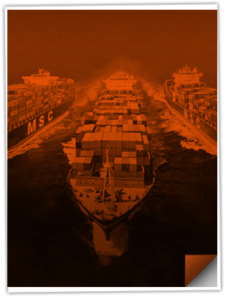Featured Headlines:
FDA Cracks Down On Phony Food Tracing Records
FDA Cracks Down On Phony Food Tracing Records
- The Food and Drug Administration (FDA) is issuing a final rule that has additional record keeping requirements for foods that are included on the Food Traceability List (FTL)—which is a list of high-risk foods designated by the US government.
- Entities that manufacture, process, pack, or hold foods are required to maintain records containing information on critical tracking events in the supply chain, such as packing, shipping, receiving, and transforming these foods.
- These requirements will help identify recipients of foods to prevent foodborne illness, as well as address credible threats of serious health consequences, or death, resulting from foods being misbranded and/or tainted.
- Click here to view the Food Traceability List (FTL).
- Click here to view the unpublished Federal Register Notice
EEI-EEI-EEI-NO!
- Did you know that, according to the US Department of Commerce, the disclosure of Electronic Export Information (EEI) to foreign entities and/or governments is not permitted?
- The information contained in the EEI filing is required to satisfy US regulatory requirements; and is considered confidential information that is not to be shared for any purpose.
- The official letter addressing requests for export documentation by foreign entities and governments can be found here.
- Click here to learn more.
OMG! The BIS Did What…?
- In October, the Department of Commerce’s Bureau of Industry and Security (BIS) issued an interim final rule containing several revisions and additions to the Export Administration Regulations (EAR).
- In summary, the rule includes the following additions and revisions:
- Added specific advances and hi-performance computing chips and computer items to the Commerce Control List (CCL) with four new ECCNs 3A090, 3B090, 4A090 and 4D090, as well as amended ECCNs;
- Added the Advanced Computing Foreign Direct Product (FDP) Rule, Supercomputer FDP Rule, and expansion of the Expanded Entity List FDP Rule;
- Added two end use/user rules for supercomputer and semiconductor manufacturing; and
- Restricted U.S. persons’ activities that support the production or development of integrated circuits in China.
- Click here to view the Federal Register Notice.
We Need Rail Enhancement
- Members of the International Brotherhood of Boilermakers, Iron Ship Builders, Blacksmiths, Forgers & Helpers (IBB) have voted down a tentative collective bargaining agreement with US railroads reached in September, becoming the third rail union to reject the deal.
- Negotiators representing the IBB and US rail management will now return to the table to hammer out their differences, with both sides having agreed to a “cooling off” period—i.e., no strikes or lockouts—until December 9th.
- Seven other unions have ratified the agreement, while the final two—the Brotherhood of Locomotive Engineers (BLET) and Sheet Metal Air, Rail, and Transportation Workers (SMART-TD)—will announce their results on November 21st. BLET and SMART-TD represent nearly half of all union employees covered by the twelve rail unions.
- A few sarcastic industry commentators hope that the extra negotiation time could also be used to improve and abbreviate the names and acronyms of the rail unions. One wag said, “ibb you ask me, ibb should not be able to comBLET a pass for a SMART-TD.”
- Rank-and-file members of all twelve unions are upset because the tentative agreement reached in September called for only one paid sick day annually. Short-term sick days were unpaid under previous collective bargaining agreements, and the Presidential Emergency Board recommended negotiating the issue on a local level, not at a national level.
- We need enhanced rail negotiation help from the government; don’t be ashamed to talk about rail enhancement, Joe!
Talking Trucking Turkey
- According to US Bureau of Labor Statistics (BLS) data, US trucking costs declined month to month in October, with the US producer price index (PPI) for long-distance truckload service falling 3.1% from September.
- However, the less-than-truckload (LTL) PPI was essentially flat, dropping just 0.3% after rising 0.3% the previous month. Surprisingly, LTL also said, “I’m not that kind of guy/girl!”
- The Cass Inferred Freight Rates Index—which is based on average rates across surface modes including truckload, rail, LTL, and parcel—dropped 3.6% in October from the previous month, but was 7.9% higher than in October 2021.
- Shippers’ spending on transportation dropped 4.9% last month from September, according to the Cass Freight Index, but was still 11.1% higher than a year ago.
- US Customs and Border Protection (CBP) says there is “reasonable suspicion” that US chassis manufacturer Pitts Enterprises evaded paying duties on chassis built in Vietnam with subcomponents from China. Since all of us continue to be DESPERATE for chassis in the hinterland, we secretly hope they get away with it. Just teasing, CBP!
- Pitts will stop importing marine chassis into the US until further notice.
- This investigation could have dire ramifications at the South Carolina Ports Authority (SC Ports), which ordered 11,000 chassis to launch a chassis pool in March 2023.
- This could also cause delays for others buying chassis—including cargo owners, chassis lessors, and trucking companies.
IMO~IMHO
- In my (our) humble opinion, IMO 2023 will not reduce effective steamship capacity enough to swing the rate pendulum back in favor of the carriers. And there was much rejoicing!
- The International Maritime Organization (IMO) has set an ambitious goal to reduce carbon intensity indicators (CII) by 40% by the end of 2024.
- Their plan begins and ends with a host of acronyms! Carriers must complete an Energy Efficiency Existing Ship Index (EEXI) to ascertain the current carbon intensity indicator (CII) per vessel. Should a vessel receive a grade of D or E (on an A-E scale), the carrier must complete a Ship Energy Efficiency Management Plan (SEEMP).
- Because the two fastest ways to reduce carbon intensity are slow steaming and scrapping, the shipping community has expressed fears that effective capacity could be reduced by as much as 15%. Will that be enough to slowly move back to a seller’s market?
- The short answer is, “not a chance, Charlie.” Studious, sensitive readers may ask, “why not and why are you calling me Charlie, Bozo?”
- While calculations and opinions vary, most wild-haired, mouth-foaming pundits peg capacity over-supply at about 10% based on current demand. Opinions on future demand are as wild and foamy as those pundits themselves!
- Drewry proclaimed an expected 2% increase in demand in 2023 vs. 2022. However, many of us know that Drewry has been hitting the sauce heavily after some gambling setbacks. The more sober analysts predict a shipping demand decline of 2-8%.
- What is certain is that new vessels are floating into action. An estimated 2.4-2.6 million TEUs of shiny new vessel capacity arrives in 2023; and this will increase capacity another 8-10%! We’ll have a lot more to say about slow steaming in our steamy International Freight News section…
Cooking the Order Books
- Let’s put the global steamship capacity (supply) realities in the spotlight. Don’t be shy, supply, be spry and fly to our eye!
- By the end of 2022, global TEU supply will have increased 5% year-over-year (YoY); this is impressively low, as the carriers effectively delayed new buildings where possible.
- However, because of the quiet accumulation of vessels during Covid (deployed to take full advantage of the Great Surge), the carriers find themselves over-supplied with capacity by about 10% as demand has all-but withered on the vine. (Yes, we said this before, but it is relevant here as well… so, again, knock it off, Charlie!)
- The big (mega?) problem for the carriers emerges as we look at their fat orderbooks. Like a spoiled child’s Christmas list, these lists are LONG! In 2023, an estimated 8.1% of today’s capacity will come on-line. And what about 2024…? A whole 8.9% more!
- When you look at the entire orderbook, over 7 million TEUs of capacity are on order; this is over 27% of current carrier capacity. That is gnarly, Charlie!
- Alphaliner tells us that of the 5,644 cellular vessels in action today, nearly half are chartered. Chartered vessels—especially if placed in action at the peak of the market— often create elevated costs for ocean carriers. The orderbook indicates that about 40% of those 7 million TEUs will be in the charter category.
- What is one thing the steamship industry is not doing right now? Thanks for asking! The answer is: scrapping old vessels. We can’t find a single case of scrapping in 2022 year-to-date (YTD), and this could be the first year in history to witness a goose egg for scraps.
- Nearly 20% of the global fleet by vessel count is now over 20-years-old. While these old rust buckets are only 8% of total capacity, they may well be the target for future scrapping.
- Sorry Charlie(s), the most likely scenario today is greater and more extreme use of slow steaming. Hey, today’s importers and exporters are used to extreme delays and long-arsed realized transits anyway! Sadly, we heard the steamship industry saying just that on a subway…Oh yes, we did!
- Slow steaming addresses carbon intensity—as you read above—but it also reduces available capacity while cutting fuel costs. When supply is killing your rates, slow those boats down, brothers and sisters!
- Insiders have guessed that steamship breakeven per 40’ sits at about $1200 for China to LA and about $2500 for China to New York. We are there now on the West Coast. We are racing to the bottom for the East Coast as well. The carriers MUST control capacity…and they will.



